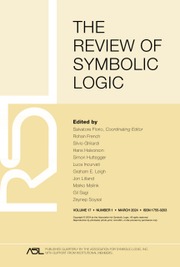No CrossRef data available.
Article contents
MODULAR SEQUENT CALCULI FOR INTERPRETABILITY LOGICS
Published online by Cambridge University Press: 08 August 2025
Abstract
An original family of labelled sequent calculi  $\mathsf {G3IL}^{\star }$ for classical interpretability logics is presented, modularly designed on the basis of Verbrugge semantics (a.k.a. generalised Veltman semantics) for those logics. We prove that each of our calculi enjoys excellent structural properties, namely, admissibility of weakening, contraction and, more relevantly, cut. A complexity measure of the cut is defined by extending the notion of range previously introduced by Negri w.r.t. a labelled sequent calculus for Gödel–Löb provability logic, and a cut-elimination algorithm is discussed in detail. To our knowledge, this is the most extensive and structurally well-behaving class of analytic proof systems for modal logics of interpretability currently available in the literature.
$\mathsf {G3IL}^{\star }$ for classical interpretability logics is presented, modularly designed on the basis of Verbrugge semantics (a.k.a. generalised Veltman semantics) for those logics. We prove that each of our calculi enjoys excellent structural properties, namely, admissibility of weakening, contraction and, more relevantly, cut. A complexity measure of the cut is defined by extending the notion of range previously introduced by Negri w.r.t. a labelled sequent calculus for Gödel–Löb provability logic, and a cut-elimination algorithm is discussed in detail. To our knowledge, this is the most extensive and structurally well-behaving class of analytic proof systems for modal logics of interpretability currently available in the literature.
Keywords
Information
- Type
- Research Article
- Information
- Copyright
- © The Author(s), 2025. Published by Cambridge University Press on behalf of The Association for Symbolic Logic


